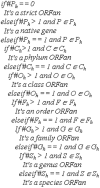ORFanFinder: automated identification of taxonomically restricted orphan genes
- PMID: 27153690
- PMCID: PMC4920126
- DOI: 10.1093/bioinformatics/btw122
ORFanFinder: automated identification of taxonomically restricted orphan genes
Abstract
Motivation: Orphan genes, also known as ORFans, are newly evolved genes in a genome that enable the organism to adapt to specific living environment. The gene content of every sequenced genome can be classified into different age groups, based on how widely/narrowly a gene's homologs are distributed in the context of species taxonomy. Those having homologs restricted to organisms of particular taxonomic ranks are classified as taxonomically restricted ORFans.
Results: Implementing this idea, we have developed an open source program named ORFanFinder and a free web server to allow automated classification of a genome's gene content and identification of ORFans at different taxonomic ranks. ORFanFinder and its web server will contribute to the comparative genomics field by facilitating the study of the origin of new genes and the emergence of lineage-specific traits in both prokaryotes and eukaryotes.
Availability and implementation: http://cys.bios.niu.edu/orfanfinder
Contact: yyin@niu.edu
Supplementary information: Supplementary data are available at Bioinformatics online.
© The Author 2016. Published by Oxford University Press. All rights reserved. For Permissions, please e-mail: journals.permissions@oup.com.
References
-
- Domazet-Loso T. et al. (2007) A phylostratigraphy approach to uncover the genomic history of major adaptations in metazoan lineages. Trends Genet., 23, 533–539. - PubMed
MeSH terms
Grants and funding
LinkOut - more resources
Full Text Sources
Other Literature Sources


